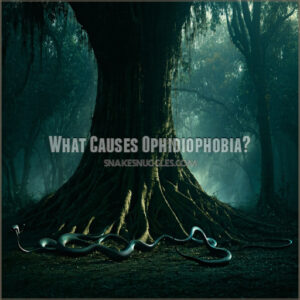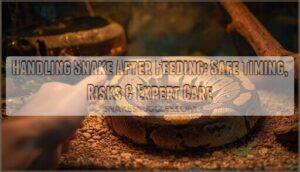This site is supported by our readers. We may earn a commission, at no cost to you, if you purchase through links.

It’s often learned, not innate.
Think about it: did you fear snakes before anyone told you to?
Early experiences and cultural stories often shape our reactions.
Ophidiophobia, the clinical term for snake fear, can stem from a mix of learned behaviors, genetics, and even evolution.
Most North American snakes you’ll encounter are harmless; their teeth are too small to cause real damage.
You’re more likely to be scratched than bitten!
Understanding snake behavior helps you feel safer.
Want to conquer your fear or just learn more?
There’s a lot more to uncover about snake fear.
Table Of Contents
- Key Takeaways
- The Fear of Snakes is Overblown
- Understanding Ophidiophobia
- The Evolutionary Roots of Ophidiophobia
- Overcoming Ophidiophobia
- Living With Ophidiophobia
- Frequently Asked Questions (FAQs)
- Why do people fear snakes?
- What is the cause of social phobia?
- Are You Afraid of snakes?
- Can a snake cause a phobia?
- Why do ancestors fear snakes?
- Are You born afraid of snakes?
- Why are humans afraid of snakes?
- Why are people disgusted by snakes?
- What percentage of the population is scared of snakes?
- Why do I always encounter snakes?
- Conclusion
Key Takeaways
- Many people’s fear of snakes is learned behavior influenced by cultural beliefs and the fears of those around us, rather than an innate, genetic predisposition.
- Most snakes are harmless and beneficial to their ecosystems. Non-venomous snakes have small teeth, and even if they break the skin, they usually leave scratches rather than deep wounds.
- Ophidiophobia, or the fear of snakes, has complex causes, including genetics, conditioning, trauma, and cultural influences. It can be effectively treated through exposure therapy, cognitive-behavioral therapy, and medication.
- The evolutionary roots of ophidiophobia suggest that early humans who could quickly detect and fear snakes had a survival advantage, passing on their genes and making us naturally sensitive to these creatures.
The Fear of Snakes is Overblown
You might think snakes are out to get you, but the truth is most pose no threat at all.
In fact, many fears about snakes are exaggerated, especially since the vast majority of species are harmless and even beneficial to their ecosystems.
Most Snakes in North America Are Harmless
You might be surprised to learn that the fear of snakes is often overblown.
Most snakes in North America are harmless, and here’s why you shouldn’t be too worried.
- Snake safety tip: Non-venomous snakes have small teeth, not designed for biting humans. Even larger snakes that break the skin usually leave scratches, not deep wounds.
- Venomous myths: Snakes only use their venom as a last resort for self-defense, so they’re not looking to bite you!
- Harmless species: Snakes won’t chase you; they might try to scare you away, but they’re not out to get you.
- North American snakes: Understanding these facts can ease your worries and promote snake conservation.
The Fear of Snakes is Often Learned, Not Innate
So, why are so many of us scared of snakes?
Well, it turns out that our fear often stems from learned behaviors and cultural beliefs rather than an innate, genetic predisposition.
Think about it: most babies and toddlers aren’t afraid of snakes.
But as we grow up, we’re influenced by the fears of those around us, maybe your parents were cautious, or you heard some tall tales about snakes.
Before you know it, you’ve got a full-blown phobia, this "learned fear" of snakes is like a conditioned response, and it’s often reinforced by media portrayals and stories.
It’s time to uncover the truth and separate the snake myths from reality.
Let’s get slithering in the direction of understanding those fear origins and how to overcome them.
Non-Venomous Snakes Are Not a Threat to Humans
You might think all snakes are dangerous, but the truth is, most snakes you’ll encounter are harmless.
Here’s the deal: their teeth are tiny and can’t really pierce our skin.
Even if a non-venomous snake tries to bite, it’ll probably just feel like a scratch.
Snakes only strike when they feel threatened, so if you leave them alone, they won’t bother you.
Here are five facts to ease your mind:
- The majority of snakes are non-venomous.
- Their teeth are too small to do any harm to humans.
- A bite from a non-venomous snake is similar to a scratch.
- Snakes only strike when they feel threatened.
- Snake conservation and understanding their behavior promote human coexistence and wildlife preservation.
Understanding Ophidiophobia
Ophidiophobia, or the fear of snakes, is a common phobia with complex causes, ranging from genetics and conditioning to trauma and cultural influences.
Understanding this phobia involves exploring its evolutionary roots, symptoms, diagnosis, and effective treatment options, which we’ll do in this section, focusing on the common phobia.
What Causes Ophidiophobia?
Ophidiophobia has a whole host of causes, and it’s different for everyone.
Take a second to think about any run-ins you’ve had with snakes, maybe one got a little too close, or you found one in your yard, experiences like these, especially as a kid, can leave a lasting impression and trigger ophidiophobia.
Sometimes, you might "catch" a fear of snakes from a family member, it’s like you absorb their fear through osmosis, on top of that, some people might be genetically predisposed to developing phobias, and snakes can be an easy target.
Our fear of snakes could also be an ancient hangover—a deep-rooted part of our evolutionary history, understanding the anxiety disorder causes is essential to addressing and overcoming ophidiophobia.
Symptoms of Ophidiophobia
When ophidiophobia strikes, it can feel like a snake in the grass—sudden and slithery.
You might find yourself in a full-blown panic, heart pounding and breath catching, just at the thought of these scaly creatures.
This fear can make you go to great lengths to avoid any potential snake encounters, severely limiting your activities and causing significant emotional distress.
The physical symptoms of ophidiophobia are no joke, either.
You may experience sweating, trouble breathing, chest tightness, nausea, dizziness, a racing heart, and tremors.
These fear responses can be overwhelming and disrupt your daily life.
Diagnosis of Ophidiophobia
When concerned about a potential snake phobia, consulting a doctor is the first step in the process of diagnosis.
They’ll begin by gathering your medical, psychiatric, and social history.
This helps create a complete understanding of your health.
Next comes a symptom assessment, evaluating the intensity of your fear of snakes and how it impacts your life.
Your doctor uses diagnostic tools like the DSM-5 to determine if your symptoms align with the criteria for ophidiophobia, officially diagnosing the phobia.
This careful process also rules out other conditions that might mimic ophidiophobia.
If needed, they may refer you to a mental health specialist for more support.
Think of it as detective work, uncovering the roots of your fear.
Understanding snake skin infection can also provide insights into the complex relationships between snakes and human psychology.
- Heart pounding like a drum solo at a rock concert?
- Palms sweating like you’re holding ice cubes?
- Thoughts racing faster than a Formula 1 car?
- Feeling dizzy like you just stepped off a rollercoaster?
- An overwhelming urge to flee the scene?
Treatment Options for Ophidiophobia
Snake fear got you tied up in knots? Unravel it with these treatment options.
First up, we’ve got snake phobia therapy, a gradual exposure kind of deal.
Think baby steps towards facing your fear in a safe space.
It’s like dipping your toes in the pool before diving into the deep end.
This approach helps you build up your courage bit by bit.
Next is cognitive behavioral therapy (CBT), which is all about changing how you think and act around snakes.
It’s like giving your brain a software update to install some cool new features.
CBT helps you see snakes in a whole new light, without all the negative thoughts getting in the way.
Then there are medications to take the edge off.
Anti-anxiety meds can give you a helping hand when things get too intense.
But these are usually just short-term helpers while you work on your long-term game.
Understanding the fear of snakes is vital to overcoming ophidiophobia, and seeking professional help is a significant step in the process of recovery.
Lifestyle treatments are also an option, like mindfulness and meditation.
These techniques are all about finding your zen and keeping stress at bay.
And let’s not forget the power of exercise to keep those anxiety gremlins at bay.
Last but not least, support groups can offer a snake-fearers’ club where you’re understood and accepted.
It’s like finding your tribe, a safe space to share and learn from each other.
The Evolutionary Roots of Ophidiophobia
Did you know your fear of snakes might come from your ancestors?
It’s thought that early humans who quickly spotted snakes were more likely to survive and pass on their genes, making us naturally sensitive to these slithery creatures.
The Fear of Snakes as an Adaptive Trait
Our ancient ancestors lived in a world where venomous snakes posed a very real threat.
This survival instinct has been passed down, becoming an evolutionary hangover.
Scientists believe that those who could quickly detect and fear snakes had a better chance of survival, and as a result, an advantage in passing on their genes.
It’s pretty wild to think that something as simple as a fear of snakes could have such a huge impact on our evolutionary journey.
| Snake Evolution | Fear Response | Adaptive Behavior |
|---|---|---|
| Pythons preyed on early humans. | Innate, genetic fear. | Avoid dangerous encounters. |
The Amygdala and The Fear Center
The fear response to snakes is deeply rooted in our brains.
The amygdala, often called our ‘fear center,’ plays a key role in processing emotional triggers and activating our stress reaction.
This tiny almond-shaped structure in our brain is responsible for quickly recognizing potential threats and triggering a fear response.
So, regarding the fear of snakes, the amygdala is a key player in this evolutionary fear, it’s like a fear center at a club, quick to spot trouble and ready to spring into action.
The Agta Negritos: a Case Study
The Agta Negritos, a tribe in the Philippines, offer a unique glimpse into the complex dynamics between humans and snakes, rooted in their traditional way of life.
This tribe’s deep connection with nature often leads to close encounters with snakes and other wildlife.
Python attacks are a regular threat, with over a quarter of adult men bearing the marks of python bites.
Notably, the Agta also hunt these pythons for food, displaying a nuanced relationship with the reptiles.
The study of species profile eastern king snakes can provide valuable insights into the behavior and habitat of various snake species, which is essential for understanding human-snake interactions, particularly the complex dynamics between humans and snakes, and the importance of preserving indigenous knowledge.
As modern influences creep into their long-standing traditions, the Agta Negritos are experiencing a cultural shift.
Their innate understanding of nature, including the dangers and intricacies of human-snake interactions, is at risk of being lost.
This tribe’s story highlights the importance of human-snake interactions and the potential consequences of losing traditional knowledge.
The tribe’s story highlights:
- The importance of preserving indigenous knowledge, which offers a window into our evolutionary past.
- The complex bond between humans and nature, which can shape our primitive reactions and ethnic phobias.
- The potential impact of tribal fears on our understanding of evolutionary fear and the human-snake relationship.
Overcoming Ophidiophobia
Overcoming ophidiophobia is achievable, and you don’t have to do it alone.
Effective treatments include exposure therapy, cognitive-behavioral therapy, and medication, which can help you manage your fear and develop the confidence to face snakes.
Exposure Therapy: Gradual Exposure to Snakes
Face your fears takes on a whole new meaning with exposure therapy.
It’s all about taking baby steps to conquer that snake phobia.
Start with pictures, then work your way up to the real deal.
It’s like a swimming lesson—you start in the shallow end, then wade into deeper waters.
Snake phobia treatment is a gradual process, and you’re in control.
Utilizing a snake therapy kit can be beneficial in this process.
| Exposure Therapy Steps | |
|---|---|
| 1. Snake pics & vids | 2. Live snakes in cages |
| 3. Snakes outside cages | 4. Brief touch |
| 5. Hold a snake |
Therapy sessions are your pool noodles, helping you stay afloat as you learn to manage fear.
Cognitive Behavioral Therapy (CBT): Changing Negative Thoughts
Cognitive Behavioral Therapy (CBT) is a game-changer for those wanting to rewrite their snake-fear story.
It’s all about guiding your thoughts in a new direction and taking charge of how you feel.
- Thought Patterns: Spot and swap those negative thoughts for realistic ones.
- Behavioral Changes: Learn cool coping strategies to keep calm when facing your fears.
- Emotional Regulation: Gain the skills to manage those big feelings and keep your cool.
CBT helps you rewrite the script and take back control.
By utilizing CBT therapy tools, individuals can develop a more balanced approach to managing their phobias.
Medication: Anti-Anxiety Medications
Anxiety got you tied up in knots?
Sometimes, medication can lend a helping hand.
Your doctor might prescribe short-term anti-anxiety meds to help you wrangle those anxiety symptoms.
It’s key to remember that prescription drugs aren’t a magic cure—they’re usually just one tool in your toolbox.
Think of them like a sidekick to other relaxation techniques.
While they can ease your anxiety, they won’t slay your snake phobia solo.
Lifestyle Treatments: Mindfulness and Exercise
Mindfulness and exercise are powerful tools to help you manage your ophidiophobia. They’re like a one-two punch, keeping you grounded and giving you the strength to face your fears. Understanding the importance of choosing the right snake can also alleviate concerns for those interested in owning a pet snake.
Try these tips:
- Mindful Breathing: Focus on your senses and anchor yourself in the present. Notice your surroundings to reduce anxiety about potential snake encounters.
- Get Moving: Exercise is a natural mood booster and stress reliever. It doesn’t have to be intense—a walk or light swim will do.
- Meditate and Move: Meditation strengthens your mental muscles. Try simple breathing exercises or yoga to ease anxiety and gain a sense of control and calm.
Support Groups: Joining a Community
Feeling alone with your snake phobia? You’re not, and there’s a community to prove it.
Support groups are a fantastic resource for connecting with others who understand your fear of snakes. Through group therapy, you’ll find a network of people keen to share their experiences and offer mutual support.
Online forums and member stories provide a wealth of peer support and strategies for overcoming your snake anxiety. Many people find comfort in snake support groups that offer specialized help.
Joining a support group empowers you with the knowledge that you’re not alone in conquering this phobia.
Living With Ophidiophobia
Living with ophidiophobia means learning to manage your fear and anxiety.
This involves educating yourself about the phobia, seeking professional help, developing coping strategies, building a support network, and identifying and avoiding triggers to manage your anxiety.
Educating Yourself About Ophidiophobia
Educating yourself is key to overcoming the cage of ophidiophobia.
You can’t fight what you don’t understand, so get to know the facts.
Here are four steps to start your journey:
- Bust some ophidiophobia myths.
- Learn about snake behavior and safety—knowing what to do when you see a snake helps calm fears.
- Find online resources and support groups to connect with others.
- Discover treatment options like exposure therapy and CBT.
Snake Phobia Facts are an important tool to face ophidiophobia.
Understanding fear mechanisms through ophidiophobia research promotes phobia awareness.
Snake education helps you overcome the fear of snakes.
By creating a snake friendly environment, individuals can better understand and appreciate these creatures, ultimately reducing their fear.
Seeking Professional Help
If your snake phobia is slithering into your daily life, seeking professional help is a smart move.
Therapists are like snake charmers, offering guidance to tame your fears. There’s exposure therapy, where you face your fears head-on, bit by bit, until you’re leading the snake charmer’s dance.
Or try cognitive behavioral therapy, which sneaks up on those negative thoughts and behaviors, helping you hiss less and hiss-ter less.
Costs vary, but don’t let that rattle you—many insurances cover snake phobia therapy. So, don’t go it alone; a therapist can help you unravel the knot of ophidiophobia.
Developing Coping Strategies
Developing coping strategies is pivotal to managing your ophidiophobia and reducing anxiety.
You can learn to tame those fears and live life on your terms.
Here are some tips:
- Breathe and Relax: Deep breathing and relaxation exercises are powerful weapons in your arsenal.
- Face Your Fears: Gradual exposure therapy lets you confront your fears in a safe space.
- Mind Over Snake: Mindfulness and positive visualization techniques train your mind to focus on the present and imagine a better future.
- Knowledge Is Power: Educate yourself about snakes and their behavior.
They help you calm down and reset when anxiety strikes.
It’s like a vaccine—a little dose of your fear helps build resistance.
Understanding them makes them less scary.
Building a Support Network
Living with ophidiophobia is easier when you’ve got a solid support crew.
Reach out to friends and family who get it and can lend a listening ear.
Consider joining support groups or connecting with peers in online forums—sharing experiences and insights can be super helpful.
Plus, you’re not alone; many folks are dealing with the same snake fears, tap into this community for support and guidance as you navigate overcoming your ophidiophobia.
Avoiding Triggers: Identifying and Avoiding Situations
Avoiding triggers is a key step in managing your ophidiophobia. It’s like mapping out a route to avoid potholes on a road trip.
Identify snake-safe spots and create safe spaces at home and work.
Steer clear of snakey situations with these 5 tips:
- Know your triggers: Be aware of situations, places, or objects that trigger your fear responses.
- Create safe environments: Make your home and workplace snake-free zones.
- Avoidance behaviors: Steer clear of high-risk areas like parks and trails.
- Situation control: If you can’t avoid a snakey situation, prepare in advance.
- Anxiety reduction: Practice relaxation techniques to stay calm and reduce fear.
Frequently Asked Questions (FAQs)
Why do people fear snakes?
It’s not just you – about half of folks worldwide get the heebie-jeebies around snakes.
This phobia might’ve evolved ’cause spotting snakes fast kept our ancestors alive.
Genes, trauma, and culture also play a part.
What is the cause of social phobia?
A social phobia, or social anxiety disorder, stems from an intense fear of negative judgment, evaluation, or rejection in social or performance situations.
It’s like feeling under a microscope, dreading every little move you make might lead to embarrassment or ridicule, which is a key aspect of social anxiety disorder.
Are You Afraid of snakes?
Snakes give me the heebie-jeebies. I’m not alone either – it’s one of the most common phobias worldwide. It’s like our brains are hardwired to fear them.
Can a snake cause a phobia?
Yes, a snake encounter can trigger a phobia.
For some, just seeing a picture or hearing a slither is enough to spark intense dread.
It’s a primal response, and you’re not alone.
Why do ancestors fear snakes?
Better safe than sorry" might be the reason why your ancestors feared snakes.
Through evolution, humans who quickly learned to fear snakes had a survival advantage.
This fear helped them pass on their genes and stay alive.
Are You born afraid of snakes?
There’s a chance you might be!
While genetics play a role, it’s not a guarantee.
Some people inherit snake phobias from their parents, but others develop the fear from conditioning or trauma.
Why are humans afraid of snakes?
Imagine you’re hiking through tall grass when suddenly, a slithering snake crosses your path. Your heart races, and you freeze. Why this intense fear? It’s evolutionary.
Why are people disgusted by snakes?
It’s not just fear that people feel regarding snakes, but also disgust.
This emotion may stem from their slithering movement, scaly skin, and association with poison and danger.
These traits trigger a primal aversion.
What percentage of the population is scared of snakes?
About half the world’s population feels anxious about snakes. It’s a common fear, but only a small percentage may qualify as ophidiophobia, which is an extreme, overwhelming phobia.
Why do I always encounter snakes?
You might live in an area with a high snake population, or your daily paths bring you into their territory.
Snakes often seek warmth and shelter, so they may be attracted to your home.
Conclusion
Afraid of snakes? You’re not alone, and science has an answer.
Understanding why people fear snakes involves unraveling a mix of learned behaviors, genetics, and evolution.
This article explored the surprising truth about ophidiophobia, offering insights into its causes, symptoms, and treatments.
By understanding snake behavior and our own reactions, we can conquer this fear and appreciate these creatures without worry, which relates to the concept of snake behavior.
- https://www.oriannesociety.org/faces-of-the-forest/why-are-we-afraid-of-snakes-and-how-do-we-overcome-that-fear/
- https://www.livescience.com/2348-fear-snakes.html
- https://www.nationalgeographic.com/newsletters/animals/article/why-afraid-snakes-march-5
- https://www.smu.edu/news/archives/2012/thomas-headland-mother-nature-network-23mar2012
- https://doi.org/10.1016/j.psychres.2016.05.024
















